A lot of explorers we meet mainly motorhome holiday in Scotland to see some dolphins and whales. And it’s not surprising; Simon King OBE, BBC presenter and wildlife film maker has said “Scotland is one of the best land-based dolphin watching hot spots in the world.”
There’s something unforgettable about watching a pod of dolphins playing in their natural habitat, or flowing alongside your boat trying to figure out what you’re doing. With miles of Scottish coast to choose from, including the famous North Coast 500 route, we’ve honed in on the top place to see dolphins in Scotland, and included a shortlist of alternatives at the end. We also included a few must-see sights along the way.
There are plenty of opportunities to get up close and personal with dolphins and whales throughout Scotland, but the most popular of all has got to be Chanonry Point on the Moray Firth. This is the most reliable place to watch dolphins anywhere in Britain.
Dolphins at Chanonry Point on the Moray Firth
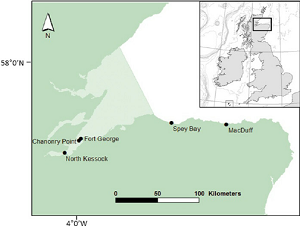
The Moray Firth is a large triangular inlet of the North Sea, and can be found on the North East coast of Scotland. It’s famous for dolphins and whales and draws visitors from all over the world. The most common species to spot here are the Bottlenose Dolphin and Harbour Porpoise, frolicking around in the bay. And the Moray Firth colony contain some of the biggest dolphins in the world because the feeding grounds are so rich in the area (which hopefully makes them easier to catch on camera!). The multitude of salmon means these dolphins can reach up to 4 metres in length and up to 650kg.
As you would expect, there are no guarantees when out dolphin-spotting, so to be safe we recommend scheduling in a few visits. However, they are often spotted in pods of up to 50 dolphins, so if you time it right, this is well worth it.
The Moray Firth covers a lot of coast in north east Scotland, but one of the best spots along it for dolphin spotting, is Chanonry Point. This narrow peninsula stretches right out into the water, and is only 5 minutes away from the nearby town of Fortrose, so you can easily spend a day or two here. The dolphin watching can even continue during lunch if you pop into the highly rated Crofter’s Bistro in Fortrose, and sit by the large window overlooking the water.
The best time to see dolphins out and about is generally when the tide starts to rise again after low tide; they are usually quite active in the area around an hour after this point. You can check out the tide forecast ahead of time online (for free) to plan your trip, or purchase a tide forecast and dolphin-watching guide from Moray Dolphins.
There’s a car park for Chanonry Point at the old lighthouse (once you travel through the golf club), but it is often crowded, so getting here by alternative means might be more enjoyable. We recommend hiring bikes from Rosemarkie Beach Cafe or Fortrose Bay Camp Site, and cycling the ‘Dolphin Mile’ along the coast.
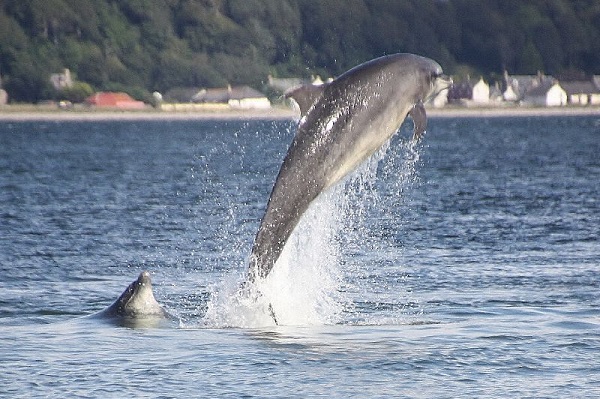
Be aware that there are no facilities at Chanonry Point, but nearby Fortrose and Rosemarkie have restaurants and cafes, toilets and additional car parking.
One top tip from locals: if there are dolphins at the popular Chanonry Point, there’s a strong chance there will be sightings later in the Inverness area, further inland along the edge of the Moray Firth.
There are a number of dolphin boat tours operating along the Moray Firth, but if you do venture out, just make sure that they comply with the Dolphin Space Programme, which is a set of guidelines aimed at encouraging responsible wildlife watching that respects the animal’s need for space. You’ll find a number of accredited boat trip operators on their website. One nearby option is Dolphin Trips Avoch, which is a short 5 min drive down the road from Fortrose.
Fortrose offers a few alternative activities if anyone in your group is tiring from the sea air; the Fortrose & Rosemarkie Golf Club won Golf Club of the year for Scotland in 2018 and is well worth a visit. Or for those more interested in history, Fortrose Cathedral is an iconic structure, largely intact but no longer in use, located right in the middle of the town. You can visit it for free, but it’s worth waiting to visit when the annual St. Boniface Fair takes place in August to learn about the history. Local residents recreate an 18th century Burgh Fair and there’s lots to see and do.
There are plenty of campsites near this popular area, including a Camping and Caravanning Club site at Rosemarkie. And if the weather isn’t exactly fantastic on your visit, don’t worry! Something you may find surprising is that dull days are actually best for dolphin viewing, as there won’t be any glare on the water to distract you.
Camping with your Motorhome at Chanonry Point, Fortrose
Rosemarkie Club Campsite on Rosemarkie Bay, is closer to Chanonry Point than Fortrose, so everything is within easy reach. The campsite sits on the edge of the bay, surrounded by woodlands, and is just a short walk to Chanonry lighthouse – perfect for impromptu dolphin viewing.
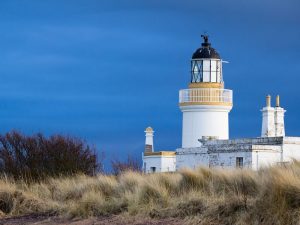
With Fortrose and Rosemarkie nearby, and Inverness just a 25 minute drive away, you won’t be short of restaurant options on your stay here. For something unique and a little unexpected in Scotland, why not head to Kool Runnings, Inverness, for some authentic Carribean and Jamaican food. They get fantastic reviews on Tripadvisor and offer a great chance to get off the typical tourist trail.
Inverness also boasts a stunning Victorian market (rebuilt in 1890 after a fire), which houses 41 unique, locally owned shops, so you can try some local produce or pick up some genuine Inverness craftware.
Visit Nearby Army Baracks, Fort George
While you’re at Chanonry Point looking for dolphins, you may spot Fort George on the opposite side of the Moray Firth in Nairn. This famous fortification, built behind massive artillery defences, is still an operational army barracks to this day and could easily fill a day’s worth of exploring. Unfortunately, you will have to drive around the Moray Firth to get here, which is 45 minutes from Chanonry Point, but at least you can expect a scenic journey!
Built following the nearby Battle of Culloden, (which you can read more about in Part 2 of our Jacobite Trail blog) around 1745, Fort George was seen as the final solution to the problematic Highlands and Jacobites; it was intended to maintain order in the north.
After finally being completed in 1769, Fort George was perhaps the strongest fortification created in Britain but by this time, it was no longer needed. It covers 42 acres and remains largely unchanged from it’s original creation in 1769, so will truly provide a trip back in time for Scotland’s explorers. The site includes a lot of buildings and spacious grounds, including a chapel, drawbridge, a cafe, the Highlander museum and even actors recreating the lives of those in the 1700. Members of the Historic Environment Scotland get free admission, otherwise it’s £9 for adults and £5.40 for children.
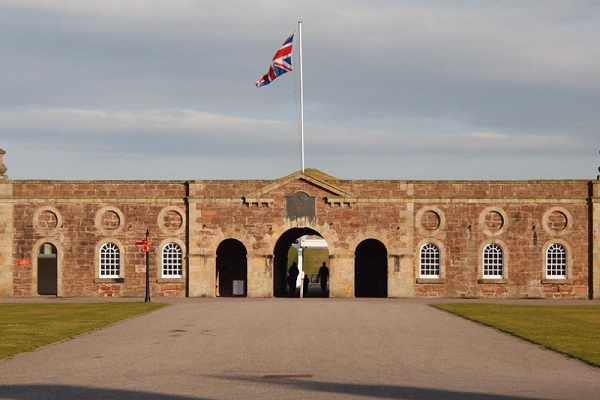
From Nairn to Spey Bay for Dolphin Viewing
When you’ve finished for the day at Fort George, the next stop on your motorhome tour of Scotland has got to be Spey Bay for more dolphin spotting. Head east along the A96 for around an hour to reach this pretty seaside area.
There’s a lovely walk in Spey Bay which takes in the coast and explores the local area. At 4 miles, it should take around an hour, and you should hopefully see some of the abundant wildlife in the area, including seals, otters, and ospreys. Visit Walk Highlands for the route maps and guide. This route involves a small section of the Speyside Way, but you could also take in the full route at 65 miles; it’s one of Scotland’s Great Trails, which follows the River Spey from Aviemore to Buckie.
Visit the Spey Bay Scottish Dolphin Centre
Whilst Chanonry Point is the most popular area for spotting dolphins (and with good reason), the cetaceans can also be spotted off the coast of Spey Bay. They’re often seen hunting salmon right at the mouth of the River Spey. Head to the Scottish Dolphin Centre for daily tours, interactive displays and exhibits, cafe, souvenir shop and more. Parking is available for motorhomes and entry is free but donations are gratefully accepted.
![Seals at Spey Bay [credit Carron Brown on Flickr]](http://www.motorhomeescapes.co.uk/wp-content/uploads/2014/04/Seals-at-Spey-Bay-credit-Carron-Brown-on-Flickr.jpg)
Head West to Mull for Whale & Dolphin Watching Boat Trips
If adventures on the water tickle your fancy, we highly recommend the Isle of Mull, on the west coast of Scotland, where the sea life is even more varied. Around 5 hours drive from Fortrose, everything you need to get settled on your motorhome trip can be found at the Explore Mull Visitor Information Centre; a fantastic resource for booking accomodation, boat trips and more! They are located on Main Street in Tobermory.
You’ll recognise Mull from the popular images of their pastel coloured houses on Tobermory harbour, made famous by children’s tv show, ‘Balamory’.
Off the coast of mull, wildlife include minke whales, harbour porpoise, seals, bottlenose dolphins and more.
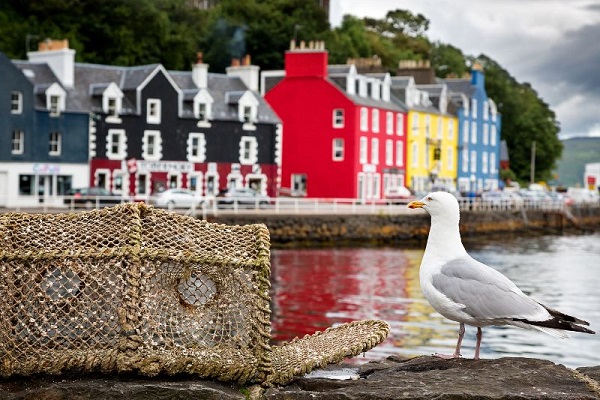
There are several boat trip operators based in Tobermory; Sea Life Surveys departs Tobermory daily on the quest for dolphin spotting and offers a range of trips lasting between 1 and 6 hours. Check out the Explore Mull website for details on booking ahead, and all boat tours in the area.
Visit Fingal’s Cave on the Isle of Staffa
A trip to the Isle of Mull has got to include a trip to the Isle of Staffa (Pillar Island); a small isle located just off the west coast of Mull. There are a number of boat tours that can take you across, with Staffa Tours in particularly departing from Iona, Tobermory and Oban.
Fingal’s Cave is named after an epic poem translated by 18th century Scots poet, James Macpherson from Ossian’s original. For history and geology fans, the hexagonal columns of the cave are similar to those of the Giant’s Causeway in Northern Ireland, and legend has it that Fingal built the causeway as a bridge between Ireland and Scotland.
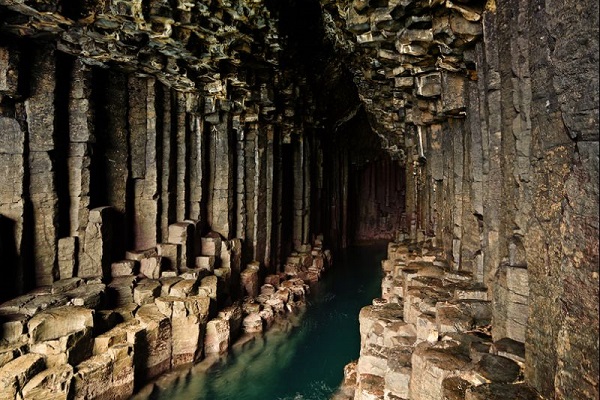
Wildlife on the Isle of Staffa is primarily made up of birds, but there are a variety of dolphins and whales in the surrounding waters.
Iona Abbey, off the coast of Mull
Whilst on the Isle of Mull, it’s also worth taking a trip on the foot ferry to Iona Abbey on the small island of Iona, just off the south west tip of Mull. It was founded in 563 by St. Columba, and is still a place of worship today.

The abbey is run by Historic Environment Scotland and is open year-round at set times. The architecture is something to be admired, having been built in the 13th – 16th centuries, and you have to pay a visit to St. Columba’s Shrine, thought to date back as far as the 9th century. It’s thought that the world famous Book of Wells was created here at the abbey, a beautifully illustrated Gospel book of prayer created by monks, which now resides in Trinity College, Dublin.
Best places to see Dolphins in Scotland
To sum up, Chanonry Point, Spey Bay and Inverness up in the north of Scotland are our top recommendations for spotting Scottish dolphins, with Chanonry Point the far and away winner. The Isle of Mull in the west is also known for having quite dolphin-rich waters. Also off the west coast, Cape Wrath, Red Point and Ardnamurchan Point are all quite popular. Heading back over to eastern Scotland, the stretch of land between Dundee and Aberdeen often features some playful dolphins, but not reliably.
But you’ll really have to commit some time if you want to see killer whales in Scotland; the best spot is way up north on the Orkney Isles, where the surrounding waters are home to these iconic creatures.
Get your dolphin watching Scotland trip planned out for this summer, and get in touch to book your motorhome today. Our modern vehicles are replaced with new models each year, and can be completely trusted on Scotland’s variety of roads as you chase dolphins up and down the coast.